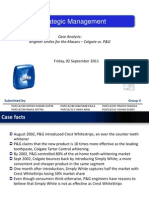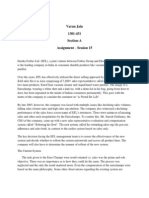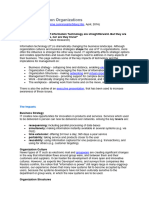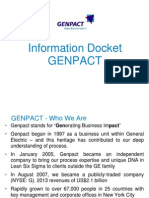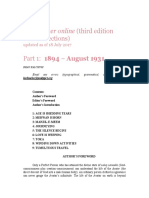0 ratings0% found this document useful (0 votes)
3K viewsNote On The CCR Framework
Note On The CCR Framework
Uploaded by
amitbharadwaj7The document discusses three categories of information technology - enterprise IT (EIT), network IT (NIT), and function IT (FIT) - and their distinct capabilities and organizational complements. It outlines general managers' responsibilities in selecting, adopting, and exploiting IT based on the technology category. EIT allows redesign of business processes and standardization across large organizations but requires imposing new workflows during adoption. NIT facilitates collaboration without predefined interactions, and complements can emerge over time. FIT's value increases with complementary changes in workflows, decision rights, and interdependencies, but these are separable from the technology.
Copyright:
© All Rights Reserved
Available Formats
Download as DOCX, PDF, TXT or read online from Scribd
Note On The CCR Framework
Note On The CCR Framework
Uploaded by
amitbharadwaj70 ratings0% found this document useful (0 votes)
3K views4 pagesThe document discusses three categories of information technology - enterprise IT (EIT), network IT (NIT), and function IT (FIT) - and their distinct capabilities and organizational complements. It outlines general managers' responsibilities in selecting, adopting, and exploiting IT based on the technology category. EIT allows redesign of business processes and standardization across large organizations but requires imposing new workflows during adoption. NIT facilitates collaboration without predefined interactions, and complements can emerge over time. FIT's value increases with complementary changes in workflows, decision rights, and interdependencies, but these are separable from the technology.
Original Description:
MIS Note on CCR Framework
Original Title
Note on the CCR Framework
Copyright
© © All Rights Reserved
Available Formats
DOCX, PDF, TXT or read online from Scribd
Share this document
Did you find this document useful?
Is this content inappropriate?
The document discusses three categories of information technology - enterprise IT (EIT), network IT (NIT), and function IT (FIT) - and their distinct capabilities and organizational complements. It outlines general managers' responsibilities in selecting, adopting, and exploiting IT based on the technology category. EIT allows redesign of business processes and standardization across large organizations but requires imposing new workflows during adoption. NIT facilitates collaboration without predefined interactions, and complements can emerge over time. FIT's value increases with complementary changes in workflows, decision rights, and interdependencies, but these are separable from the technology.
Copyright:
© All Rights Reserved
Available Formats
Download as DOCX, PDF, TXT or read online from Scribd
Download as docx, pdf, or txt
0 ratings0% found this document useful (0 votes)
3K views4 pagesNote On The CCR Framework
Note On The CCR Framework
Uploaded by
amitbharadwaj7The document discusses three categories of information technology - enterprise IT (EIT), network IT (NIT), and function IT (FIT) - and their distinct capabilities and organizational complements. It outlines general managers' responsibilities in selecting, adopting, and exploiting IT based on the technology category. EIT allows redesign of business processes and standardization across large organizations but requires imposing new workflows during adoption. NIT facilitates collaboration without predefined interactions, and complements can emerge over time. FIT's value increases with complementary changes in workflows, decision rights, and interdependencies, but these are separable from the technology.
Copyright:
© All Rights Reserved
Available Formats
Download as DOCX, PDF, TXT or read online from Scribd
Download as docx, pdf, or txt
You are on page 1of 4
The CCR Framework
The Different Categories
An enterprise information technology (enterprise IT, or EIT) is one that imposes new processes, and a network
information technology (network IT, or NIT) as one that lets new processes emerge over time as the result of
users interactions. The third technology category, called function IT (FIT) affects single tasks or functions
rather than multi-function business processes.
IT-based Capabilities
The three technology categories offer distinct and non-overlapping capabilities. All enterprise information
technologies, for example, deliver similar capabilities, even though the EIT category comprises applications
developed by many vendors and positioned for distinct markets and customers. While capabilities are similar
within the categories of FIT, EIT, and NIT, they are largely different across them. Function IT, for example,
does not offer a subset of enterprise ITs capabilities, or even a significant intersection with them.
Capabilities from Function IT
Increased experimentation capacity. FIT lets knowledge workers such as scientists, engineers, and
financial analysts conduct huge numbers of trials and quickly explore the solution space of their work
(BMW and Ducati).
Greater precision. If a system is well-understood, it can be modeled very accurately with FIT. This lets
knowledge workers conduct very precise experiments, understanding the effects of very small changes
and finding optima (Ducati).
Capabilities from Network IT
Facilitating collaboration. Network technologies let people work together without mandating or trying
to predict how they will interact. This flexibility means that network technologies support many modes
of collaboration (Blogs and Wikis at DrKW, wiki at VistaPrint).
Allowing expression of judgment. Network technologies give their users a voice and, in many cases, a
forum to express themselves. Prediction markets, for example, let people express their judgments about
the likelihood of future events (Blogs).
Capabilities from Enterprise IT
Design and redesign of business processes. Enterprise technologies allow general managers to define
and then deploy novel business processes, even ones that cut across many organization groups
(OTISLINE, Mount Auburn).
Standardization of workflows across an arbitrarily large footprint. Once a business process has been
embedded within EIT, it can be replicated and distributed cheaply, widely, and with high fidelity. One of
the problems of distributed companies is a reduced ability to control what happens far from
headquarters; EIT provides a way to address this problem (Mount Auburn, Zara).
Monitoring of activities and events, often in something close to real time. Another problem of corporate
scale has been managers inability to observe the performance of remote operations; available reports
are often both out-of-date and too aggregated. With EIT in place, managers can get a more precise and
current picture of what is happening throughout an enterprise (OTISLINE).
ITs Complements
The capabilities mentioned above are maximized when organizations that adopt new IT also adopt a set of
organizational complements.
Enterprise IT systems are used to define, then deploy new work structures new workflows, interdependencies,
and decision right allocations -- across multiple groups. In other words, enterprise technologies impose new
complements on adopting organizations, and these complements are largely inseparable from the technology
itself. It is not possible to introduce an ERP system without to some extent increasing interdependence, re-
allocating decision rights, or imposing new workflows. Think of how a new workflow was introduced when
Mount Auburn implemented the POE system. With the implementation of OTISLINE, the decision rights of the
field officers changed.
Network IT facilitates interactions among people and groups, but does not pre-define these interactions. In
other words, network IT does not impose complements. Some network technologies, however, contain
mechanisms to let new complementsnew workflows, interdependencies, and decision-right allocations
emerge over time as people use the technologies. We talked about the training wiki in DrKW, and that is a good
example of how workflows and interdependencies change over time in the case of Network IT. The decision on
who provides information to the employees of an organization changes if the company introduces an internal
blog. However, note that no one in the company is imposing these structures. No manager actually asked for the
training wiki. It is the employees who realize the potential of Network IT and create these work structures
themselves.
Function ITs value is increased by the complements listed above. With FIT, the organizational complements
of IT are separable from the technology itself. FIT can be adopted with or without any changes to
complements. We saw in class how BMWs styling software could be introduced without putting any
complements in place. However, Chris Bangle had to bring in the complements to get the maximum benefits.
He announced one day that he would drop the idea of the styling software if usage does not pick up in another
few weeks. This triggered off a change in interdependencies, and also a subsequent change in the workflows as
styling software experts started collaborating with the designers. We also looked at the example of Team New
Zealand (one of the participants in Americas Cup), and noted how the managers asked the team members to
collaborate and decide on the design of the boat. This changed the decision rights. However note that this had to
be initiated by the managers.
General Managers IT-related Responsibilities
General managers have three main IT-related responsibilities: to select I T based on desired capabilities,
then work during adoption and exploitation to put ITs organizational complements in place. With EIT,
adoption is typically the greater responsibility; with FIT and NIT, in contrast, exploitation often demands the
most from general managers.
General Managers Three Roles in IT Success
Selection
The Selection process should always be inside out across the different categories. Inside-out approach means
that managers should always look at the capabilities that they want to acquire from IT, and then look at the
technology space to select the appropriate IT. In contrast, the outside-in approach is about looking at what
others (competitors, industry leaders) are doing and then selecting the software without going into an analysis of
the capabilities that the organization needs to acquire from IT.
Adoption
The Adoption process for FIT entails identifying the complements properly, and then implementing them, what
Chris Bangle did in BMW (explained above).
This stage is extremely important for EIT. As complements are imposed on the employees, they naturally resist
the system. The key to addressing these issues is to identify the potential pockets of resistances right at the
selection phase, and then build a plan on how to counter resistance. The next step is to build consensus in the
organization on the importance, and benefits of implementing the system. However, business leaders, and
managers should be prepared to push the system through in spite of resistance. More often than not
implementation of EIT demands a slightly heavy handed approach.
The adoption of Network IT mainly involves making the employees aware of the technologies.
Exploitation
Exploitation of FIT involves fine tuning the complements, similar to what Team New Zealand did (explained
above).
The exploitation of EIT is easier than adoption of EIT as people are ready to use the system and get benefits
from it since they have gone through the pain of adopting it. Sometimes we use FIT on top of EIT to exploit
EIT, for example statistical software tools (FIT) can provide great insights into the business, once the company
standardizes data using EIT.
For Network IT, exploitation is important as well as subtle. Once the employees start using the technology, and
once the complements emerge over time, the responsibility of the mangers is to ensure that the complements are
sustained and enhanced. For example, at DrKW, one of the managers sustained and enhanced the complements
by asking his subordinates to use the wiki to enter questions they want him to ask at meetings with the senior
management.
Source Proprietary material of Prof Andrew McAfee. Used with permission.
You might also like
- Solution Canonical Decision Problem PDFDocument24 pagesSolution Canonical Decision Problem PDFSaadat Ullah Khan100% (1)
- Design Thinking AnswerDocument3 pagesDesign Thinking AnswerDileep y75% (16)
- Moonka Auto: Recruiting Salespeople - Case AnalysisDocument7 pagesMoonka Auto: Recruiting Salespeople - Case AnalysisRituparna Chakraborty100% (1)
- Running Head: Singapore Metals LimitedDocument9 pagesRunning Head: Singapore Metals LimitedAijaz ShaikhNo ratings yet
- Sec A - Group 14 - Migros Turkey - Scaling Online OperationsDocument6 pagesSec A - Group 14 - Migros Turkey - Scaling Online OperationsSumit100% (1)
- Chandpur Enterprise Limited - Steel DivisionDocument3 pagesChandpur Enterprise Limited - Steel DivisionVinodSingh100% (1)
- Report of Semi-Expendable Property IssuedDocument16 pagesReport of Semi-Expendable Property IssuedAlgie Reñon100% (1)
- ProjectCalcs KEYDocument72 pagesProjectCalcs KEYHaider Shadfan100% (1)
- Case-Dont Bother MeDocument7 pagesCase-Dont Bother MeSaurav Demta100% (3)
- Bharti Airtel in Africa CaseDocument3 pagesBharti Airtel in Africa CaseSreeda Perikamana50% (4)
- Lion Financial ServicesDocument3 pagesLion Financial Servicesjeff mathews0% (1)
- Chemalite, Inc. (B) Case BackgroundDocument2 pagesChemalite, Inc. (B) Case BackgroundAnuragNo ratings yet
- Amaranth Advisors: Burning Six Billion in Thirty DaysDocument24 pagesAmaranth Advisors: Burning Six Billion in Thirty DaysRosalina MaharanaNo ratings yet
- 21PGDM152 - RACHIT MRINAL - Don't Bother Me, Can't Cope AssignmentDocument6 pages21PGDM152 - RACHIT MRINAL - Don't Bother Me, Can't Cope AssignmentRachit Mrinal100% (3)
- Case Analysis Strategic Management Brighter Smiles For The Masses - Colgate vs. P&G (Download To View Full Presentation)Document13 pagesCase Analysis Strategic Management Brighter Smiles For The Masses - Colgate vs. P&G (Download To View Full Presentation)mahtaabk83% (12)
- Eureka Forbes - Case Analysis. How To Manage The Selling EffortDocument4 pagesEureka Forbes - Case Analysis. How To Manage The Selling EffortVarun JainNo ratings yet
- Group 2 LTCLDocument6 pagesGroup 2 LTCLShubham Srivastava0% (3)
- Davey Brothers Watch Co. SubmissionDocument13 pagesDavey Brothers Watch Co. SubmissionEkta Derwal PGP 2022-24 Batch100% (1)
- Megacard CorporationDocument14 pagesMegacard CorporationMitesh Patel100% (2)
- Unilever in India: Hindustan Lever S Project Shakti - Marketing FMCG To The Ruralconsumer Case AnalysisDocument5 pagesUnilever in India: Hindustan Lever S Project Shakti - Marketing FMCG To The Ruralconsumer Case Analysismahtaabk100% (4)
- Appex CorporationDocument5 pagesAppex CorporationNandanaNo ratings yet
- LP Formulation - Chandpur Enterprises LimitedDocument10 pagesLP Formulation - Chandpur Enterprises LimitedMagaly Stefany Sáenz CárdenasNo ratings yet
- Shodh HousingDocument12 pagesShodh HousingVishal Jogani100% (2)
- Case Analysis: OMNITEL PRONTO ITALIADocument5 pagesCase Analysis: OMNITEL PRONTO ITALIAmahtaabk100% (5)
- Dominion Motors AnalysisDocument4 pagesDominion Motors AnalysisUday Kiran100% (1)
- Colgate Precision Toothbrush Case Study AnalysisDocument5 pagesColgate Precision Toothbrush Case Study Analysisbinzidd007100% (8)
- Executive Summary: Make Credit Terms ConsistentDocument3 pagesExecutive Summary: Make Credit Terms Consistentrajinder.sobti2991100% (3)
- Cases of Pronouns-Grade 10Document5 pagesCases of Pronouns-Grade 10Salve Petiluna33% (3)
- Case Study of D.LIGHT DESIGN IN INDIADocument10 pagesCase Study of D.LIGHT DESIGN IN INDIAKRook NitsNo ratings yet
- Case-1 - MM1 - Vora and Company - Anirban Kar - EPGP-12A-022Document6 pagesCase-1 - MM1 - Vora and Company - Anirban Kar - EPGP-12A-022Anirban KarNo ratings yet
- C1 MobonikDocument1 pageC1 MobonikKANIKA GORAYANo ratings yet
- Pashu Khadya Company Limited (PKCL)Document6 pagesPashu Khadya Company Limited (PKCL)Rahul Gandhi100% (1)
- Don't Bother MeDocument13 pagesDon't Bother MeMrinal KumarNo ratings yet
- Asian ToysDocument2 pagesAsian ToysHbbekn jjdbhh100% (1)
- Sales SoftDocument19 pagesSales Softsaurabhdhingra948950% (4)
- Operations Management-II End Term Paper 2020 IIM IndoreDocument14 pagesOperations Management-II End Term Paper 2020 IIM IndoreRAMAJ BESHRA PGP 2020 Batch100% (3)
- Karnataka Engineering CaseDocument5 pagesKarnataka Engineering CaseJSNo ratings yet
- Sunwind AB Case StudyDocument6 pagesSunwind AB Case StudyTanmoy BoseNo ratings yet
- Logistics - Karnataka Engineering CaseDocument9 pagesLogistics - Karnataka Engineering CaseVamsee Krishna Vyas B0% (1)
- Sale SoftDocument6 pagesSale SoftRahul AgarwalNo ratings yet
- Case Analysis of Tanishq: Positioning To Capture The Indian Women's HeartDocument4 pagesCase Analysis of Tanishq: Positioning To Capture The Indian Women's HeartDebmalya DuttaNo ratings yet
- 3 M Case AnalysisDocument4 pages3 M Case Analysisniraj100% (1)
- Black and Decker Corporation (A)Document3 pagesBlack and Decker Corporation (A)Rohan Srivastava33% (3)
- Usha Martin: Competitive Advantage Through Vertical IntegrationDocument9 pagesUsha Martin: Competitive Advantage Through Vertical IntegrationsafwanhossainNo ratings yet
- Case Analysis of Nitish@ Solutions UnlimitedDocument19 pagesCase Analysis of Nitish@ Solutions UnlimitedBaldeep Kaur100% (1)
- 7-2 John Holtz (C) Case Study SolutionsDocument14 pages7-2 John Holtz (C) Case Study SolutionsAashima Grover100% (1)
- Case Analysis Chapter 3Document4 pagesCase Analysis Chapter 3angelll0% (1)
- Moore Medical CorporationDocument6 pagesMoore Medical CorporationMitesh Patel100% (1)
- Case Problem EZ Trailers, Inc.Document3 pagesCase Problem EZ Trailers, Inc.Something ChicNo ratings yet
- AddonsDocument11 pagesAddonsShreyas Marulkar100% (1)
- Metron SolutionDocument11 pagesMetron Solutionamitesh7224No ratings yet
- Operations Management-II Case - Megacard CorporationDocument7 pagesOperations Management-II Case - Megacard CorporationDikshma PaulNo ratings yet
- BOS Brands ChallengesDocument1 pageBOS Brands ChallengesRohanNo ratings yet
- BBVA Compass: Marketing Resource Allocation: Ho Kim, Ph.D. Assistant Professor of MarketingDocument27 pagesBBVA Compass: Marketing Resource Allocation: Ho Kim, Ph.D. Assistant Professor of MarketingJoaquín Norambuena Escalona100% (1)
- Case 3 SectionC Group 1 (Repaired)Document3 pagesCase 3 SectionC Group 1 (Repaired)SANDEEP AGRAWALNo ratings yet
- Strategic Management: Case Analysis: Brighter Smiles For The Masses - Colgate vs. P&GDocument14 pagesStrategic Management: Case Analysis: Brighter Smiles For The Masses - Colgate vs. P&GHimanshu VermaNo ratings yet
- Assignment 1Document3 pagesAssignment 124pgp037No ratings yet
- It Framework ReportDocument17 pagesIt Framework ReportjesusNo ratings yet
- IT Summary Justified Times New RomanDocument2 pagesIT Summary Justified Times New Roman24pgp037No ratings yet
- Topic 1 - Impact of IT On OrganizationsDocument3 pagesTopic 1 - Impact of IT On OrganizationsEaindra KhinNo ratings yet
- Bite-Sized Training™: What Is IT Management?Document11 pagesBite-Sized Training™: What Is IT Management?Joulo YabutNo ratings yet
- Auditing in A Cis EnvironmentDocument283 pagesAuditing in A Cis EnvironmentElisabeth Henanger100% (1)
- Unit 1 It InfrastructureDocument6 pagesUnit 1 It Infrastructureshreyashpatra48No ratings yet
- International Journal On Commerce and ManagementDocument12 pagesInternational Journal On Commerce and Managementamitbharadwaj7No ratings yet
- PWC Trigeneration PDFDocument19 pagesPWC Trigeneration PDFamitbharadwaj7No ratings yet
- Ebook Classic TitlesDocument10 pagesEbook Classic Titlesamitbharadwaj7No ratings yet
- Generator Protection Class DefinedDocument18 pagesGenerator Protection Class Definedamitbharadwaj7100% (2)
- Data Bulletin: Benefits of Thermal Magnetic Circuit BreakersDocument9 pagesData Bulletin: Benefits of Thermal Magnetic Circuit Breakersamitbharadwaj7No ratings yet
- 01 GenPact OverviewDocument9 pages01 GenPact Overviewamitbharadwaj7No ratings yet
- Genpact Company Overview DocketDocument16 pagesGenpact Company Overview Docketamitbharadwaj7No ratings yet
- Case Analysis - Problem StatementDocument8 pagesCase Analysis - Problem Statementamitbharadwaj7No ratings yet
- FM Assignment - EVA and DuPont Analysis For CompaniesDocument10 pagesFM Assignment - EVA and DuPont Analysis For Companiesamitbharadwaj7No ratings yet
- Case Analysis - Aqualisa QuartzDocument2 pagesCase Analysis - Aqualisa Quartzamitbharadwaj7100% (1)
- Job AnalysisDocument8 pagesJob Analysisamitbharadwaj7No ratings yet
- Zynga IT InfrastructureDocument7 pagesZynga IT Infrastructureamitbharadwaj7No ratings yet
- HRM Case Study - Red - LobsterDocument1 pageHRM Case Study - Red - Lobsteramitbharadwaj70% (1)
- Coal Based Power GenerationDocument4 pagesCoal Based Power Generationamitbharadwaj7No ratings yet
- Company Act 2013 Seminar PresentationDocument24 pagesCompany Act 2013 Seminar Presentationamitbharadwaj7No ratings yet
- My CV 2019Document10 pagesMy CV 2019Freddy LimNo ratings yet
- Gerunds After PrepositionsDocument13 pagesGerunds After PrepositionsCenobioNo ratings yet
- Ghostly Desires by Arnika FuhrmannDocument58 pagesGhostly Desires by Arnika FuhrmannDuke University Press100% (2)
- Maximizing The Value of A Risk-Based Audit Plan.Document4 pagesMaximizing The Value of A Risk-Based Audit Plan.Arco Priyo DirgantoroNo ratings yet
- ST AugustineDocument29 pagesST AugustineBermelyn grace BorneaNo ratings yet
- 1632-Article Text-1303-1-10-20161025Document9 pages1632-Article Text-1303-1-10-20161025anisa bayagonNo ratings yet
- LEO Pharma Annual Report 2013Document27 pagesLEO Pharma Annual Report 2013karpeoNo ratings yet
- Pages From Nick Dear - FrankensteinDocument7 pagesPages From Nick Dear - FrankensteinTorniakyNo ratings yet
- Borjas, 1987Document24 pagesBorjas, 1987isisbernalNo ratings yet
- Dead SilenceDocument3 pagesDead SilenceNur Nabila Natasya RazifNo ratings yet
- Get National Geographic Readers: Stacey Abrams (Level 2) Melissa H. Mwai Free All ChaptersDocument64 pagesGet National Geographic Readers: Stacey Abrams (Level 2) Melissa H. Mwai Free All Chaptersheokazlif100% (5)
- Meningioma BrochureDocument16 pagesMeningioma BrochureAyu Rahmi AMyNo ratings yet
- 31 Buce vs. Court of AppealsDocument1 page31 Buce vs. Court of AppealsJemNo ratings yet
- Daftar Nama Pengawas Try Out AkbarDocument85 pagesDaftar Nama Pengawas Try Out AkbarSuhadi HadiNo ratings yet
- 10 Fever Nature's Own Healing ProcessDocument33 pages10 Fever Nature's Own Healing ProcessAnonymous fO8xe7rMyA100% (1)
- 2001-0425 Public Program, Version 2, Istanbul, Turkey - enDocument12 pages2001-0425 Public Program, Version 2, Istanbul, Turkey - enSimbad MNo ratings yet
- The Ethics of Stealth Marketing: Undercover AgencyDocument14 pagesThe Ethics of Stealth Marketing: Undercover AgencyJawad AliNo ratings yet
- ManualTherapy Sample ToC Author BiogDocument67 pagesManualTherapy Sample ToC Author BiogNaveenNo ratings yet
- Singular and Plural Nouns: Flor de Maria Garcia PandoDocument24 pagesSingular and Plural Nouns: Flor de Maria Garcia PandoMavelin Pacco OviedoNo ratings yet
- ShopBot Specsheet 5axisDocument2 pagesShopBot Specsheet 5axisolaolaolaola123No ratings yet
- The LEGO Neighborhood Book Build Your Own Town 1st Edition Lyles Brian Lyles Jason All Chapter Instant DownloadDocument49 pagesThe LEGO Neighborhood Book Build Your Own Town 1st Edition Lyles Brian Lyles Jason All Chapter Instant DownloadbakolajiehanNo ratings yet
- Lord Meher Online (Third Edition: With Corrections) Part 1: 1894 - August 1931Document798 pagesLord Meher Online (Third Edition: With Corrections) Part 1: 1894 - August 1931Srinivasarao PVNo ratings yet
- Impact of Maneka Gandhi CaseDocument51 pagesImpact of Maneka Gandhi CaseSameeksha XalxoNo ratings yet
- SameerSalvi ResumeDocument5 pagesSameerSalvi ResumevaidehiNo ratings yet
- Math10.C5L1 Experiments, Outcomes, Samplespace, AndeventsDocument27 pagesMath10.C5L1 Experiments, Outcomes, Samplespace, AndeventsmiggyNo ratings yet
- MiguelDocument6 pagesMiguelAvedis Ferguson100% (1)
- Examiner Moderator Marks Marks Signature Stamp Signature Stamp Date DateDocument5 pagesExaminer Moderator Marks Marks Signature Stamp Signature Stamp Date DatePDPPBIR0621 Mohd Shahmee Bin Abu SamanNo ratings yet














